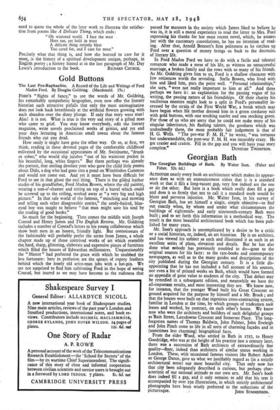Georgian Bath
The Georgian Buildings of Bath. By Walter Ison. (Faber and Faber. 52s. 6d.) ALTHOUGH nearly every book on architecture which makes its appear- ance does so with an announcement either that it is a standard work or that it fills a long-vacant gap, very few indeed are the one or do the other. But here is a book which really does fill a gap and does it so firmly that not to call it a standard work would be blunt and perverse injustice. Mr. Walter Ison, in his survey of Georgian Bath, has set himself a single, simple objective—to find out exactly when, by whom and under what circumstances the buildings of eighteenth- and early nineteenth-century Bath were built ; and to set forth this information in a methodical way. The result is the most beautiful architectural book which has been pub- lished for many years.
Mr. Ison's approach is uncomplicated by a desire to be a critic or a social historian, or, indeed, an art historian. He is an architect, and has viewed his subject as such and illustrated it as such in an excellent series of plans, elevation and details. But he has also done what nobody has previously troubled to do—gone to the original sources for his facts: to the rate-books and contemporary newspapers, as well as to the many guides and descriptions of the city published during the Georgian century. It is a little dis- appointing that he has not included a full account of his sources, nor even a list of printed works on Bath, which would have formed an appendix of great value to students of the city. That defect may be remedied in a subsequent edition, and meanwhile we have the all-important results, and most interesting they are. We know now, for instance, that the younger Wood built his Great Crescent on ground acquired for the purpose by himself and a Mr. Brock ; and that the houses were built on that ingenious cross-contracting system, familiar in London at the time, by which groups of tradesmen took leases and worked, by contract, on each other's house. We know now who were the architects and builders of such delightful groups as 'Bath Street, Lansdowne Crescent and Somerset Place. The long- forgotten names of Thomas Baldwin, John Palmer, John Eveleigh and John Pinch come to life in all sorts of charming facades and in (sometimes less charming) biographical facts.
From the elder Wood, who settled in Bath in 1727, to Henry Goodridge, who was at the height of his practice just a century later, there was a succession of Bath architects of extraordinarily fine quality—finer, indeed than architects of similar status working in London. These, with occasional famous visitors like Robert Adam or George Dance, gave us what we justifiably regard as (in a strictly architectural sense) our most beautiful city. That only now has that city been adequately described is curious, but perhaps char- acteristic of our national attitude to our own arts. Mr. Ison's book does indeed fill a gap, and it only remains to add that his text is accompanied by over 250 illustrations, in which strictly architectural photographs have been wisely preferred to the seductions of the






























 Previous page
Previous page